Spatial organization of RYRs and BK channels underlying the activation of STOCs by Ca(2+) sparks in airway myocytes
- PMID: 21746845
- PMCID: PMC3149436
- DOI: 10.1085/jgp.201110626
Spatial organization of RYRs and BK channels underlying the activation of STOCs by Ca(2+) sparks in airway myocytes
Abstract
Short-lived, localized Ca(2+) events mediate Ca(2+) signaling with high efficiency and great fidelity largely as a result of the close proximity between Ca(2+)-permeable ion channels and their molecular targets. However, in most cases, direct evidence of the spatial relationship between these two types of molecules is lacking, and, thus, mechanistic understanding of local Ca(2+) signaling is incomplete. In this study, we use an integrated approach to tackling this issue on a prototypical local Ca(2+) signaling system composed of Ca(2+) sparks resulting from the opening of ryanodine receptors (RYRs) and spontaneous transient outward currents (STOCs) caused by the opening of Ca(2+)-activated K(+) (BK) channels in airway smooth muscle. Biophysical analyses of STOCs and Ca(2+) sparks acquired at 333 Hz demonstrate that these two events are associated closely in time, and approximately eight RYRs open to give rise to a Ca(2+) spark, which activates ∼15 BK channels to generate a STOC at 0 mV. Dual immunocytochemistry and 3-D deconvolution at high spatial resolution reveal that both RYRs and BK channels form clusters and RYR1 and RYR2 (but not RYR3) localize near the membrane. Using the spatial relationship between RYRs and BK channels, the spatial-temporal profile of [Ca(2+)] resulting from Ca(2+) sparks, and the kinetic model of BK channels, we estimate that an average Ca(2+) spark caused by the opening of a cluster of RYR1 or RYR2 acts on BK channels from two to three clusters that are randomly distributed within an ∼600-nm radius of RYRs. With this spatial organization of RYRs and BK channels, we are able to model BK channel currents with the same salient features as those observed in STOCs across a range of physiological membrane potentials. Thus, this study provides a mechanistic understanding of the activation of STOCs by Ca(2+) sparks using explicit knowledge of the spatial relationship between RYRs (the Ca(2+) source) and BK channels (the Ca(2+) target).
Figures
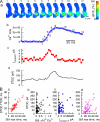
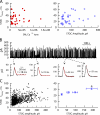
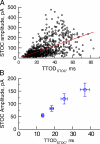


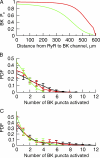

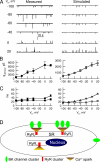
Similar articles
-
Dynamics of signaling between Ca(2+) sparks and Ca(2+)- activated K(+) channels studied with a novel image-based method for direct intracellular measurement of ryanodine receptor Ca(2+) current.J Gen Physiol. 2000 Dec;116(6):845-64. doi: 10.1085/jgp.116.6.845. J Gen Physiol. 2000. PMID: 11099351 Free PMC article.
-
Local Ca(2+) transients and distribution of BK channels and ryanodine receptors in smooth muscle cells of guinea-pig vas deferens and urinary bladder.J Physiol. 2001 Jul 15;534(Pt. 2):313-26. doi: 10.1111/j.1469-7793.2001.t01-3-00313.x. J Physiol. 2001. PMID: 11454953 Free PMC article.
-
A close association of RyRs with highly dense clusters of Ca2+-activated Cl- channels underlies the activation of STICs by Ca2+ sparks in mouse airway smooth muscle.J Gen Physiol. 2008 Jul;132(1):145-60. doi: 10.1085/jgp.200709933. J Gen Physiol. 2008. PMID: 18591421 Free PMC article.
-
Signaling between SR and plasmalemma in smooth muscle: sparks and the activation of Ca2+-sensitive ion channels.Cell Calcium. 2003 Sep;34(3):211-29. doi: 10.1016/s0143-4160(03)00124-6. Cell Calcium. 2003. PMID: 12887969 Review.
-
Sarcoplasmic reticulum and membrane currents.Novartis Found Symp. 2002;246:189-203; discussion 203-7, 221-7. Novartis Found Symp. 2002. PMID: 12164309 Review.
Cited by
-
Estrogenic Modulation of Ionic Channels, Pumps and Exchangers in Airway Smooth Muscle.Int J Mol Sci. 2023 Apr 26;24(9):7879. doi: 10.3390/ijms24097879. Int J Mol Sci. 2023. PMID: 37175587 Free PMC article. Review.
-
MicroRNA-210 Mediates Hypoxia-Induced Repression of Spontaneous Transient Outward Currents in Sheep Uterine Arteries During Gestation.Hypertension. 2021 Apr;77(4):1412-1427. doi: 10.1161/HYPERTENSIONAHA.120.16831. Epub 2021 Mar 1. Hypertension. 2021. PMID: 33641365 Free PMC article.
-
Pregnancy Increases Ca2+ Sparks/Spontaneous Transient Outward Currents and Reduces Uterine Arterial Myogenic Tone.Hypertension. 2019 Mar;73(3):691-702. doi: 10.1161/HYPERTENSIONAHA.118.12484. Hypertension. 2019. PMID: 30661479 Free PMC article.
-
A computational model of large conductance voltage and calcium activated potassium channels: implications for calcium dynamics and electrophysiology in detrusor smooth muscle cells.J Comput Neurosci. 2019 Jun;46(3):233-256. doi: 10.1007/s10827-019-00713-9. Epub 2019 Apr 25. J Comput Neurosci. 2019. PMID: 31025235
-
On a Magical Mystery Tour with 8-Bromo-Cyclic ADP-Ribose: From All-or-None Block to Nanojunctions and the Cell-Wide Web.Molecules. 2020 Oct 16;25(20):4768. doi: 10.3390/molecules25204768. Molecules. 2020. PMID: 33081414 Free PMC article. Review.
References
-
- Bao R., Lifshitz L.M., Tuft R.A., Bellvé K., Fogarty K.E., ZhuGe R. 2008. A close association of RyRs with highly dense clusters of Ca2+-activated Cl− channels underlies the activation of STICs by Ca2+ sparks in mouse airway smooth muscle. J. Gen. Physiol. 132:145–160 10.1085/jgp.200709933 - DOI - PMC - PubMed
Publication types
MeSH terms
Substances
Grants and funding
LinkOut - more resources
Full Text Sources
Miscellaneous

